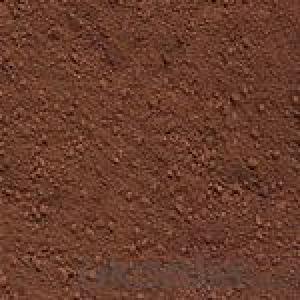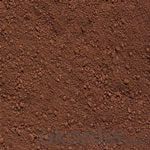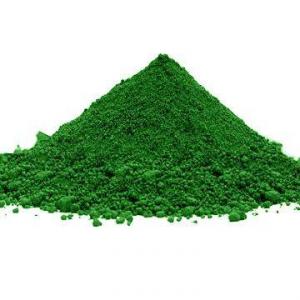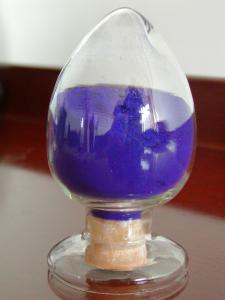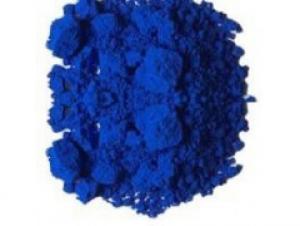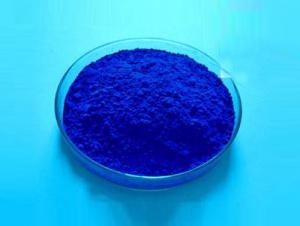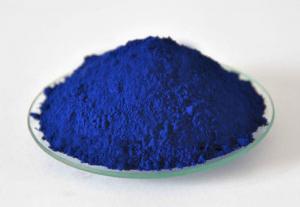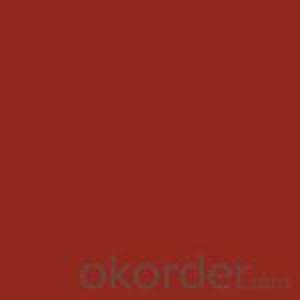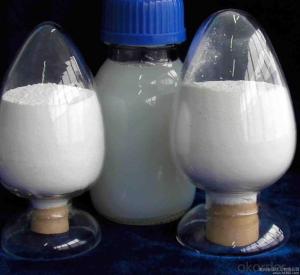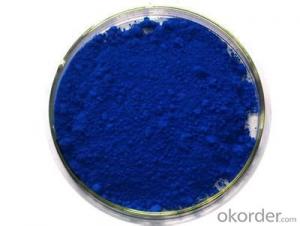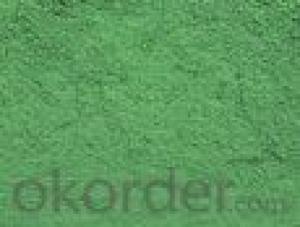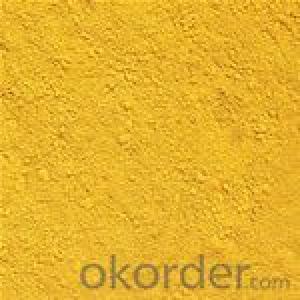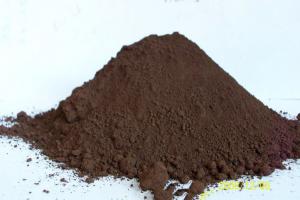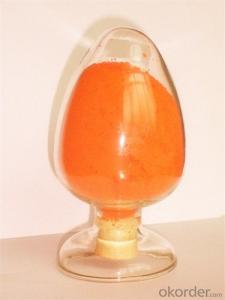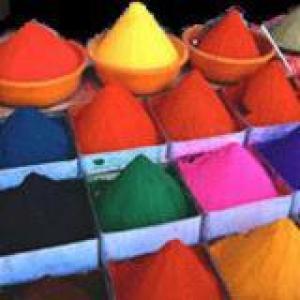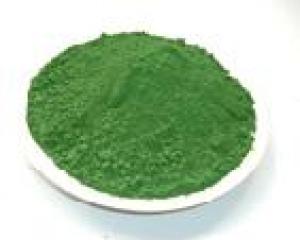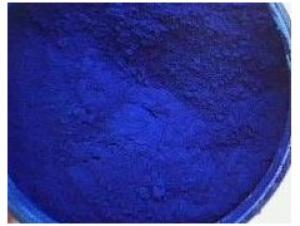iron oxide brown pigment 686
- Loading Port:
- China Main Port
- Payment Terms:
- TT OR LC
- Min Order Qty:
- -
- Supply Capability:
- -
OKorder Service Pledge
OKorder Financial Service
You Might Also Like
Quick Details
· CAS No.: 1309-37-1;1317-60-8;1332-37-2
· Other Names: Ferric Oxide
· MF: Fe2O3
· EINECS No.: 215-168-2;215-275-4;215-570-8
· Place of Origin: (Mainland)
· Usage: Ceramic Pigments, Coating Pigment, Cosmetic Pigment, Ink Pigments, Plastic & Rubber Pigment, Leather Pigments, cement/concrete parts pigments
· Model Number: 686
· Type: Iron Oxide
· Style: Inorganic Pigment
· Product Name: iron oxide brown pigment
· Color: black
· Type: 686
· Fe2O3 component: from 90% to 98%
· Moisture: black, <1.5% red,yellow,green<1%
· PH value: 4-7
· Apparent Density: 0.7g/cm^3-1.1 g/cm^3
· Particle shape: spherical,irregular,acicular
· Inspection/certification: SGS,CIQ,BV,Asia Inspection
· Package: pp or colored valve or super bags
Packaging & Delivery
Packaging Details: | 1. 25kgs thermo-fusible bags 2. 25kgs paper bag with plastic inner 3. 25kgs colored valve bag 4. 600kgs or 1000kgs super or jumbo bags 5. 1 tons or 1.25 tons wooden pallet 6. other customized package like the drum etc |
Delivery Detail: | within 15-20 days after signing the contract |
Specifications
iron oxide black pigment
1.red/yellow/blue/green/brown
2.SGS/BV/ISO9001 inspected
3. tinting strength>95%
4. chromatism<1
1: Brief introduction of the iron oxide pigment:
The Iron oxide pigment is made by iron, hydrochloric acid, sodium hydroxide which is adopted wet processing method...
As the most important inorganic colorant, the iron oxide pigment is characterized with strong tinting strength,easy
dispersibility,excellent fastness and good weather resistant, it is widely used in the concrete roofing tile,paver,
stucco,masonary,paint,coating,rubber, plastic,paper and leather industries...
2. The technique data and specification of the iron oxide pigment:
Item | Index |
Primary color |
|
Diluted color |
|
Iron content (Fe3O4) 105℃ drying%≥ | 90 |
Fineness (325 mesh wet sieve residue)%≤ | 0.3 |
Oil absorption, g/100g | 20-25 |
Moisture & 105℃ volatile% | 1.5 |
Water solubles% ≤ | 0.3 |
Water suspended matter PH value | 4-7 |
Relative tinting strength (compared with standard sample%) ≥ | 100±2 |
3. The application of the Iron oxide pigments:
A: Iron oxide pigment is used as dye or colorant in various prefabricated concrete parts and architectural products and material,
it is directly added into cement to color up various indoor and outdoor cement surface, for example: wall,terrances,ceilings,
pillars,corridors,roads, car-parking stairs as well as building ceramic and glazed ceramics.. like facing bricks, floor tile, roofing
tiles,panels,terrazzo,mosaic tiles,artificial marbles,etc...
B: Iron oxide pigment is also applicalbe to different coating and protetive materials, including water-based exterior wall paint,
and powder coating, as well as to oil paints. such as epoxy,alkyd,amidogen, and some other primier and finish paint.. it can be
used in toy paints,decorative paints,furniture lacuquers,electrophoresis paints, and enameled paints,etc..
C:Iron oxide pigment is also used coloring material for plastic products like the thermosetting plastic and thermoplasstic,
as well as in rubber products, such as tyre tubes for bycle,automobile,etc..
4. The package and transporation, loading conditions of the Iron oxide pigments:
A: The package of Iron oxide pigment:
a:25kgs thermo-fusible bags
b:25kgs paper bag with plastic inner
c:25kgs colored valved bag
d:600kgs or 1000kgs super or jumbo bags
e:1 ton or 1.25 tons wooden pallet
f:other customized package like the drums etc..
B: The quantity of each iron oxide pigments can be loaded:
a: Iron oxide red 25kgs craft paper bags, 22 MT per 20ft container
b: Iron oxide yellow 25kgs craft paper bags, 13MT per 20ft container
c: Iron oxide black 25kgs craft paper bags, 20MT per 20ft container
5. Why choose us as the supplier of the iron oxide pigments:
A: Professional:
21 years experieance focusing on pigment industry, professional guide and throughly market analysis..
B: Quality control:
high quality raw material, advanced equipment, accept SGS,BV,Asia inspection, ISO9001 certification..
C: Competitive price:
strictly control the production cost, factory producing, lower product profit strategy
D: Best service:
quick delivery time, 24 hours quick response, quick reaction for any questions or problems
E: Sample free:
All sample is free, customer just need to pay the charges of express, when the sample is qualified,
will pay back the sample express fees back from trial order..
G: Good credit:
attend the china internal coating exibiton held in guangzhou and shanghai
6. The situation of our customers :
We only focus on pigments,especially inorganic pigments including iron oxide pigment, chrome yellow and
orange,XD titanium pigments, new iron titanium anticorrosion powder.. we got ISO9001certification and accept
SGS,BV,Asia inspection or other third party inspection before shipment..
We has been exported our goods to south korea, malaysia,Russia,Somalia,Ethiopia,
America,Brazil,Central asia for good quality and best credit...
7. Other informations:
A:Moq: 5 Tons
B:Payment Term: TT or L/C sight
C: H.S code: 2821100000
- Q: can the pigment know as Chinese purple form a matter wave in certain circumstances?
- Scientists explore atomic mysteries of ancient pigment LOS ALAMOS, N.M., Nov. 18, 2004 -- University of California scientists from the National High Magnetic Field Laboratory, Pulsed Field Facility at Los Alamos National Laboratory, working with colleagues from Tokyo Metropolitan University, the University of Buenos Aires in Argentina, the National Institute of Chemical Physics and Biophysics in Estonia, the National High Magnetic Field Laboratory in Tallahassee, Florida and the University of Tokyo, have discovered an ideal candidate for Bose-Einstein condensation in the ancient Chinese pigment, Han Purple. In research featured recently on the cover of Physical Review Letters, the team describes how the application of a strong magnetic field to Han Purple (BaCuSi2O6) creates a gas of bosonic spin triplet excitations. The field acts as a chemical potential causing the weakly interacting bosonic gas to undergo Bose-Einstein condensation (BEC) when the temperature is reduced to minus 453 degrees Fahrenheit, six orders of magnitude higher than the temperature normally required for BEC in atomic gases.
- Q: What does the word pigment mean?
- it means the color. like the pigment of your eyes could be green, blue, hazel. or the pigment of your skin. it's a fancy-pants word for color.
- Q: PLEASE TRY!, to awnser ANY of the questions below.~What factors cause leaves to change colors. Where do these colors come from?~What are the names of the specific chemical pigments that cause the colors we see (reds, yellows, purples, browns, greens etc.) These are the same pigments (chemical that causes color) that give fruit their different colors.~What is the process (how it happens) that cause leaves to fall off of the branches. Explain at the cell level. (picture)Please try to awnser. Thanks.
- 1shorter days and cooler temperatures 2they emerge from being obscured by the more numerous chlorophyll 3carotenoids,etc 4 senescense then abscission.the abscission zone has thin-walled cells,plant hormones decrease,a separation layer forms,cells form suberin thus isolating leaf from stem,fall
- Q: i was thinking of this all day long and then i thought of posting this question for you to help me sort it out
- Pigments are chemicals inside living things that absorb certain types of light. In plants, the pigment chlorophyll in leaves absorbs sunlight for photosynthesis to work, where the energy comes from. Chlorophyll absorbs all light except green, which is reflected. That's why most plants are green. NOT the other war around. :) :)
- Q: I need to know the classes and sub classes of pigments classification
- INORGANIC PIGMENTS Oxides Chromates Sulphides Sulphoselenides Sulphates Silicates Ferrocyandies Carbonates Metallic Mixed Metal Oxides Vanadates ORGANIC PIGMENTS Organic pigments are generally categorized into six types : ?Monoazo Pigments ?Diazo Pigments ?Acid and base dye Pigments ?Phthalocyanine Pigments ?Quinacridone Pigments ?Other polycyclic Pigments if you want more detail: ORGANIC PIGMENTS: 1.AZO Pigments : Monoazo Yellow and Orange Pigments. Disazo Pigments. β-Naphthol Pigments. Naphthol AS Pigments (Naphthol Reds). Azo Pigment Lakes (Salt Type Pigments). Benzimidazolone Pigments. Disazo Condensation Pigments. Metal Complex Pigments. 2.POLYCYCLIC Pigments: Phthalocyanine Pigments. Quinacridone Pigments. Perylene and Perinone Pigments. Diketopyrrolo–Pyrrole (DPP) Pigments. Thioindigo Pigments. Isoindolinone and Isoindoline Pigments. 3. Anthraquinone Pigments. Anthrapyrimidine Pigments. Flavanthrone Pigments. Pyranthrone Pigments. Anthanthrone Pigments. 4. Dioxazine Pigments. Triarylcarbonium Pigments. Quinophthalone Pigments
- Q: In photosynthesis whats the difference between primary and accesory pigments?
- Primary pigments are molecules that convert light energy to chemical energy directly; chlorophyll is the primary pigment in all photosynthetic organisms. Accessory pigments are molecules that absorb photons which are not captured by chlorophyll. The presence of accessory pigments (found in the thylakoid membranes of plants) allows phototrophs (plants, algae, and cyanobacteria) to capture energy from the sun that would otherwise go to waste. The two most common types of accessory pigments are carotenoids and phycobilins. Some examples of carotenoids in common plants are: beta-carotein (carrot orange), lutein (marigold yellow), and lycopene (tomato red). Phycobilins are found only in red algae or cyanobacteria. The two most common phycobilins are: phycoerythrin (red), and phycocyanin (blue). The presence of accessory pigments in plants is masked by the presence of chlorophyll during the Spring and Summer seasons; that's why leaves are green most of the time. The color change from green to red, orange, or yellow that we observed during the Fall season is caused by the absence of chlorophyll; the accessory pigments are always present until the leaves fall as the trees go into dormant mode.
- Q: light absorption, which pigments are involved?
- All photosynthetic organisms contain one or more organic pigments capable of absorbing visible radiation, which will initiate the photochemical reactions of photosynthesis. The three major classes of pigments found in plants and algae are the chlorophylls, the carotenoids and the phycobilins. Carotenoids and phycobilins are called accessory pigments since the quanta (packets of light) absorbed by these pigments can be transferred to chlorophyll. Chlorophylls chlorophyll a - present in all higher plants and algae chlorophyll b - present in all higher plants and green algae chlorophyll c - diatoms and brown algae chlorophyll d - red algae (chlorophyll a is present in all photosynthetic organisms that evolve O2.) Chlorophyll molecules contain a porphyrin 'head' and a phytol 'tail'. The polar (water-soluble) head is made up of a tetrapyrrole ring and a magnesium ion complexed with the nitrogen atoms of the ring. The phytol tail extends into the lipid layer of the thylakoid membrane. Carotenoids (carotenes and xanthophylls) Carotenes: -carotene - higher plants and most algae $-carotene - most plants some algae xanthophylls: luteol, fucoxanthol and violaxanthol Carotenoids contain a conjugated double bond system of the polyene type (C-C=C-C=C). Energy absorbed by carotenoids may be transferred to chlorophyll a for photosynthesis. Phycobilins (found mostly in red and blur-green algae): phycoerythrin phycocyanin allophycocyanin )
- Q: What are leaf Pigments?
- Pigments that are present in the leaf that impart colour to the leaf are called leaf pigments. They are chemical compounds. Green colour in plants is due to Chlorophyll. Cholorophyll are also of different types Chlorophyll-A, Chlorophyll-B, Chlorophyll-C and Chlorophyll-D. Different colours are imparted to plants by different pigments. Some are Xanthophyll and Carotenoids.
- Q: How are plant pigments involved in photosynthesis?
- Plant pigments - as other pigments - interact with light to absorb only certain wavelengths. In plants the different sorts of pigments are useful to absorb available wavelengths of light and enable photosynthesis in shadow, in bright sunshine, in deep sea etc.: each pigment reacts with only a narrow range of the spectrum, there is usually a need to produce several kinds of pigments, each of a different color, to capture as much as possible of the sun's energy.
Send your message to us
iron oxide brown pigment 686
- Loading Port:
- China Main Port
- Payment Terms:
- TT OR LC
- Min Order Qty:
- -
- Supply Capability:
- -
OKorder Service Pledge
OKorder Financial Service
Similar products
Hot products
Hot Searches
Related keywords
